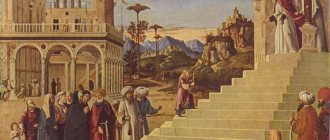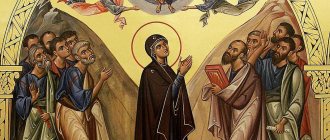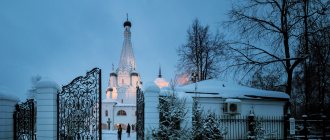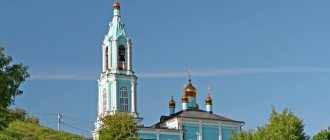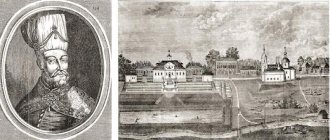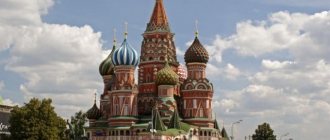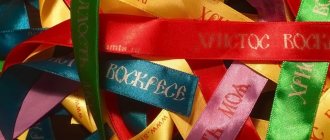The Entry into the Church of Our Most Holy Lady Theotokos and Ever-Virgin Mary is one of the twelve (from the Slavic “twelve” - twelve), that is, the largest Orthodox holidays, established in memory of the fact that the parents of the Mother of God solemnly led Her at the age of three to the Jerusalem temple, under whom she lived until her betrothal to the righteous Joseph. The Feast of the Entry of the Most Holy Theotokos into the Temple is celebrated annually on December 4 (November 21, old style) and has 1 day of pre-celebration and 4 days of post-celebration.
Presentation of the Blessed Virgin Mary into the temple. Holiday event
We learn about the events of the earthly life of the Most Holy Theotokos The canonical Gospels do not tell anything about the birth, childhood and youth of the Blessed Virgin Mary, therefore we can learn about the events of the feast of the Entry into the Temple of the Blessed Virgin Mary from later texts - the Greek “Proto-Gospel of James” (second half of the 2nd century) and the Latin “Gospel of Pseudo-Matthew” "(IX century), in which oral traditions are recorded.
It is known that the parents of the Mother of God, Joachim and Anna, were childless for a long time. Praying that the Lord would resolve their infertility, they made a vow to dedicate the born child to God. When the Blessed Virgin was three years old, in fulfillment of the promise, her parents, accompanied by relatives and people close to them with lighted lamps, solemnly led Her to the Jerusalem Temple. The High Priest Zechariah and, at the inspiration of God, led her into the Holy of Holies. This was a temple room where the high priest himself could enter only once a year, after making a special sacrifice. This is how the festive service says about this extraordinary, exceptional event: “ The angels saw the introduction of the Most Pure Mother of God, and were surprised: how the Virgin enters the Holy of Holies .” (The angels, seeing the introduction of the Most Pure Mother of God, were surprised: how the Virgin entered the Holy of Holies).
It must be said that at that time the Jerusalem temple was restored after the Babylonian captivity. The Ark of the Covenant was no longer in it - it had disappeared. The Holy of Holies was empty, there was only a stone slab in place of the main shrine.
A mysterious, symbolic event took place: instead of the lost Ark of the Covenant, the high priest introduces the Virgin Mary - the one who became the Mother of God, the new Icon, the Ark. The time of the New Testament was coming, the Nativity of Christ was approaching. The Church’s liturgy also speaks about this: the Feast of the Entry of the Virgin Mary precedes the Nativity of Christ. It’s still a long way before Christmas, Lent has just begun, but they are already beginning to sing during the evening service: “Christ is born, give thanks!”
The most complete theological interpretation of the introduction of the Mother of God into the Temple is given by St. Gregory Palamas in his Homily “On the Entry of the Most Holy Theotokos into the Temple.” In it, the saint tells the history of the holiday, gives his opinion about the reasons for God’s election of Mary as the mother of Jesus Christ, and in conclusion explains the reason for her introduction into the Holy of Holies of the Jerusalem Temple:
...why the Chosen One from the beginning of the century among the elect turned out to be the Holy of Saints. Having Her body purer than the spirits themselves purified by virtue, so that it could receive the very Hypostatic Word of the Eternal Father, the Ever-Virgin Mary, as the Treasure of God, according to her heritage was now placed in the Holy of Holies, so that in due time, as it was, she could serve for enrichment and to a premium decoration.
Library of the Russian Faith Teaching on the Entry into the Temple of the Blessed Virgin Mary. Great Menaion of Cheti →
Read online in original
Signs, customs, fortune telling
In the old days they firmly believed in omens, especially on this day. The introduction was called “the gates of winter.” People noticed that if a snowball falls before the holiday, it will not last long and will melt quickly. But if after December 4, then it will lie until spring.
Watched the weather:
- If it is very frosty on this day, then the winter will be harsh and the summer will be hot. It was true that after this day there would be no warmth.
- Clear weather means a good grain harvest.
- A cloudy and warm day means a warm winter, but an unimportant grain harvest.
- Lots of snowdrifts - for a strawberry harvest.
- Frost on December 4 foreshadows cold days at Christmas.
- If the bell rings dullly, it will snow.
In ancient times, the owner of the house went out into the street with bows to greet the Moroz brothers. He asked the Morozovs for health to the whole family, and in their honor the stoves were heated as hot as possible.
Names were given great importance. On this day, boys were most often called Vladimir, Nikolai, Pavel, Alexey, girls - Ada. But even in the old days, not everyone adhered to the calendar because of superstition.
Traditions
Ancient customs are returning - writing letters to Santa Claus. It is not necessary to send it. Just write a letter with your wish, burn it on December 4th, sending your request to the Universe.
Since in the old days there were fairs everywhere, it was considered a good omen to buy winter clothes for yourself or your household. Sleighs were in particular demand. Today you don’t buy a sleigh, but you can buy a hat or gloves. Any winter item will protect against difficulties and bring good luck.
At the Introduction, pies were baked and guests were invited to attract good luck and wealth. We went outside for a sleigh ride. Today they go ice skating and skiing.
Presentation of the Blessed Virgin Mary into the temple. history of the holiday
Having entrusted their only child to God, Joachim and Anna returned home. The Mother of God remained to live at the temple. Pious women who dedicated themselves to God raised Her along with other pious girls. Mary prayed, diligently read the Holy Scriptures and did handicrafts. Church tradition says that an Angel of God often appeared to her and brought food. This is also stated in the festive service: “ Raised by heavenly bread, the Virgin, in the Church of the Lord, truly, gave birth to the world’s belly bread, the Word... ” (Brought up, nourished by heavenly bread in the Church of the Lord, the Virgin gave birth to the world the bread of life - the Word, i.e. Gentlemen). However, Saint Jerome of Stridon points out: “If someone asked me: how the Most Holy Virgin spent her youth, I would answer him: that is known to God Himself and the Archangel Gabriel, Her constant guardian.”
The beginning of the celebration of the Entry of the Most Holy Theotokos into the temple dates back to the 4th century, when references to the holiday appeared in the writings of St. Gregory of Nyssa . Sermons on the feast of the Presentation of the Virgin Mary by the Patriarchs of Constantinople Germanus and Tarasius (8th century) have been preserved. Instructions about the holiday are contained in some month books of the same time. Although the Feast of the Entry has been known since the first centuries of Christianity, at first it was not celebrated as solemnly as it is now. Church historians say that he became one of the Twelves only after the 14th century.
Vvedensky fortune telling
As mentioned above, fortune-telling using dumplings is traditional. The night from December 4 to 5 shows prophetic dreams. Before going to bed, in order to see the house of their future spouse, the girls said:
Holy Introduction, lead me to where I should live.
Yuletide fortune-telling with calling the betrothed-mummer into a dream was also popular during the Introduction. To do this, an object was left under the pillow or bed, for example, a locked lock or a bridge made of twigs. Before going to bed they said:
Betrothed-mummer, come and open the lock (or “cross the bridge”).
In a dream, a person will appear, chosen by fate as a spouse. He will fulfill the request. When planning to have prophetic dreams, we did not read our prayers at night. The pectoral cross should be removed, but street clothes should be left on.
Presentation of the Blessed Virgin Mary into the temple. Divine service
The stichera for the Feast of the Entry, written by George of Nicomedia, depict this event (procession with lamps, meeting the high priest in the temple, etc.) and the inner meaning of the holiday. Then the purpose of “introducing the Holy Virgin into the temple” is clarified. She is brought to the temple to be brought up into God’s dwelling and to prepare with herself the Throne of God and then to reconcile us with God, to “deify” our nature corrupted by sin.
Two canons for the holiday, repeating the thoughts of the stichera, were compiled by George Nicomedia and Basil Pagariot, Archbishop of Caesarea. The Gospel (Luke X, 38-42. XI, 27-28) speaks of Christ’s stay in the house of Martha and Mary. The Apostle (Heb. IX, 1-7) contains the idea that the Most Holy Theotokos was typified in the Old Testament by the tabernacle.
Library of the Russian Faith Canon of the Entry into the Temple of the Blessed Virgin Mary →
Read online
The first proverb (Ex. XL, 1-5, 9-10, 16, 34-35) tells about the construction of the tabernacle by Moses and how the cloud shone around it. The second paremia (1 Kings VII, 51; VIII, 1, 3, 7, 9-11) tells about the solemn transfer of the Ark of the Covenant to the temple built by Solomon and how the glory of the Lord filled the temple (both the tabernacle and the temple served as a prototype of the Virgin Mary, who was the abode of the Glory of the Father - the Son of God). The third paremia is the same as on the feast of the Nativity of the Virgin Mary (Ezek. XLIII, 47; XLIV, 1-4).
Troparion for the holiday. Church Slavonic text:
Today the blessing is presented, and 3 the preaching of salvation, in the Church of the Holy Spirit, there is a lot of good news, and 3 the good news is given to all. t0y and3 we2 loudly cry out, rejoice at watching the construction and fulfillment.
Russian text:
Today is a foreshadowing of God’s favor and a foreshadowing of the salvation of people. The Virgin openly appears in the temple of God and announces Christ to everyone. We, too, will loudly shout to her: Rejoice, fulfillment of the Creator’s providence for us.
Kontakion for the holiday. Church Slavonic text:
Precious tsRkvi sp7sova, many-honest features of the dv7tsa, the sacred treasure of the glory of b9iz, today is introduced into the day, the blessing of the commonwealth of the divine. yu4zhe sing ѓнGлі б9іи, єєєє4ст сіннбсназ.
Russian text:
The Most Holy Virgin, the most pure Church of the Savior and the valuable palace, the sacred repository of the glory of God, is today introduced into the house of the Lord and brings with her the grace of the Divine Spirit. The Angels of God sing about her: She is a heavenly village.
Prayer
Oh, Most Holy Virgin, Queen of Heaven and Earth, before the ages the chosen Bride of God, who in recent times came to the lawful temple to betrothal to the Heavenly Bridegroom! You left Your people and Your father’s house in order to offer Yourself a pure and immaculate sacrifice to God, and You were the first to take a vow of perpetual virginity. Grant us also to keep ourselves in chastity and purity and in the fear of God all the days of our lives, so that we may be temples of the Holy Spirit, especially help everyone, in imitation of Thy, who live in the monasteries and who have betrothed themselves to the service of God in the purity of virginity to lead their lives from youth to bear the good and light yoke of Christ, holyly keeping one’s vows. You, O All-Pure One, spent all the days of Your youth in the temple of the Lord, far from the temptations of this world, in constant vigil in prayer and in all mental and physical abstinence, help us to repel all the temptations of the enemy from the flesh, the world and the devil that have come upon us from our youth , and overcome them with prayer and fasting. You are in the temple of the Lord with the abiding angels, you have been adorned with all the virtues, especially with humility, purity and love, and you have been brought up worthily, so that you will be ready to contain in your flesh the Incontainable Word of God. Grant us, too, possessed by pride, intemperance and laziness, to be clothed in all spiritual perfection, so that each of us, with Your help, may prepare from us the wedding robe of our souls and the oil of good deeds, so that we may appear, without naz and unprepared, to meet our Immortal Bridegroom and Your Son. Christ, our Savior and our God, but may He receive us with the wise virgins in the abode of paradise, where, with all the saints, grant us to glorify and glorify the all-holy name of the Father and the Son and the Holy Spirit, and Your merciful intercession always, now and ever, and forever and ever. Amen.
See also:
Word of John of Kronstadt on the Feast of the Entry into the Temple of the Blessed Virgin Mary
Iconography of the Feast of the Entry of the Blessed Virgin Mary into the Temple
Vvedensky Vladyka Monastery: monastery of St. Alexis
Presentation of the Blessed Virgin Mary into the temple. Folk traditions of the holiday
The day of the Feast of the Entry into the Temple of the Blessed Virgin Mary is marked in the folk calendar with a number of special beliefs and customs associated with them. A number of common folk song legends have been preserved, which at the same time are laudatory magnifications of the Blessed Virgin who first entered the temple of the Lord. “You were brought to church, you were rewarded as a bishop and preferred by an angel,” one of them begins. This beginning-“starter” is followed by a refrain that is repeated at the very end of the verse: “The virgins, Her neighbor, will be brought after Her into the Holy of Holies!” The story, interrupted by this quatrain, continues: “Zechariah rejoices, prophetically announces, triumphs with joy. The elder stretches out his hand. She calls her the queen and sings with sweet voices. Today the old man lifts up the Virgin, let him raise up Eva, and destroy the ancient oath. Eva, now rejoice: behold, the Virgin has appeared this day and sat down on the throne. The Holy Spirit overshadows, and the Virgin receives, and appears to everyone at three years of age. Cherubs fly in, surround them with seraphim, and sing the voices of the Trisagion. The angel brings food, and the Virgin receives it, stretching her hand upward”... Another verse praising this holiday begins with words about the Mountains of Zion, on which God “laid a covenant, opened the light of God from above to us from heaven, and watered our hearts with streams of words.” In the third, the “patriarchs” are invited to triumph, “all the virgins” are invited to stay awake and “rejoice with the prophets.” In the fourth, foremother Eve is having fun. And in all of them one can clearly hear the reverent feeling of the song-creator people, giving honor and praise to the Mother of God.
This holiday was considered in Rus' to be women's, "women's" holidays, like the day of the Intercession of the Virgin Mary, the martyrs Catherine and Barbara, as well as Paraskeva Friday.
On the Feast of the Introduction, according to folk traditions (if there was enough snow), sleigh rides began. “Time for business, time for fun!” - says a Russian person even today, alternating his work and worries with rest. Our ancestors treated the first sleigh ride as a special celebration. The “season” was opened by newlyweds, married in the church.
In the old days, the Feast of the Introduction was the day of the first winter auction. The Vvedensky fairs began immediately after the end of the morning divine liturgy and were often located in the squares adjacent to the Vvedensky churches. At the fairs one could purchase a variety of goods, have fun and enjoy the treats offered. It was at the Vvedensky fairs that sleighs were sold - single, double, triple; everyday and festive, decorated with skillful carvings or paintings, as well as horse harnesses for the winter. In addition, at the Vvedensky fairs they always sold frozen fish, as well as autumn preparations brought from surrounding villages - dried mushrooms and berries for the Lenten table of the townspeople. At holiday fairs in winter, peddlers sold pies “hot and hot” and treated everyone to hot sbiten, a herbal infusion with honey.
Winter fair. Boris Kustodiev
The Feast of the Entry has always been associated with the natural cycle of the entry of nature from autumn into winter. Based on the weather on this holiday, conclusions were drawn about the state of nature on the days of all subsequent winter holidays: “In Vvedenye there is frost - all holidays are frosty, and warmth - all holidays are warm.” In Rus', many proverbs have been formed that are associated with the signs of this time of year. In some Russian regions, a thaw often occurred during the Introduction, then they said:
- Vvedensky frosts do not cause winter;
- The introduction breaks the ice;
- Before the Introduction, if snow falls, it will melt.
If frost had already set in by this time, they said:
- The introduced frosts put mittens on the peasant, set the cold, brought winter to mind;
- On Introduction - thick ice cream;
- Introduction came - winter brought;
- If deep winter begins with Vvedenya, prepare deep bins - there will be a rich harvest of grain.
Holiday traditions
The church holiday, like most others, is celebrated with traditions and feasting. Festive services are usually held in the morning. At the same time, the clergy dress in blue clothes, and the process itself is accompanied by chants.
What can you do on this day
On a church holiday you can visit each other. This tradition today has been adopted from Ancient Rus', when it was important as a sign: if a man visits the house first, the year will be successful and happy, and if a woman, all the bad luck can befall the house.
What not to do on December 4
Since ancient times, it was generally accepted that on this holiday it was impossible to dig and plow the earth until spring, so before its onset they usually stocked up on clay. It was also forbidden to make grated hemp and beat out linen, as this could cause bad weather.
Today, on the day of the holiday, you cannot do house cleaning, laundry, or work on the land. It is also forbidden to swear, use foul language and spread gossip. It is not recommended to lend money.
What foods and dishes can you eat?
The holiday is celebrated during the Orthodox Nativity Fast, so eating meat is prohibited, but it has always been allowed to consume fish. In ancient times, fairs were held where one could enjoy fresh baked goods: pancakes, baked goods, gingerbread. The tradition has been adopted to this day.
Presentation of the Blessed Virgin Mary into the temple. Icons
The earliest depictions of the Feast of the Entry of the Mother of God into the Temple on icons are fragments of 12th-century epistilia from the Vatopedi Monastery and the monastery of the Great Martyr Catherine in Sinai. The center of the composition is the small, fragile figure of the Virgin Mary in the Jerusalem Temple. The high priest who came out to meet Her, the righteous Zechariah, the father of John the Baptist, bows to Her. The Mother of God as an animated temple that contained the incontainable Divinity.
Introduction to the temple. Epistilium of the templon (fragment). End of the 12th century Monastery of St. Catherine, Sinai, Egypt
In the late Byzantine period, a change occurred in the iconographic scheme: immediately behind the Mother of God are the Jewish virgins and the parents of the Mother of God, the righteous Joachim and Anna. At the top of the composition is a scene of the Mother of God being fed by an angel. The Blessed Virgin is represented inside the temple, standing on the steps of the Holy of Holies.
Introduction to the Temple of the Blessed Virgin Mary with scenes from her life. XVI century State Tretyakov Gallery, Moscow
Icon of the Presentation of the Virgin Mary. XV century. Novgorod
Icon of the Presentation of the Virgin Mary. XIV century. State Russian Museum, St. Petersburg
Introduction to the temple. From the festive ceremony. OK. 1497 Kirillo-Belozersky Historical, Architectural and Art Museum-Reserve
Iconography of church celebration
On numerous icons, the plot of which is dedicated to the events of the Introduction, the image of the Queen of Heaven is always contained in the center. In such paintings, the three-year-old Virgin Mary appears dressed in a maforium, which in the past was the traditional clothing of married women. Near the future Mother of God are depicted her righteous parents, who, fulfilling their vow to God, brought their only child to the Jerusalem Temple.
The icons also contain the image of the priest Zechariah, who was destined to become the father of the great prophet John the Baptist. Traditionally, religious images contain an image of the same staircase with 15 steps that little Mary managed to overcome without the support of adults.
Temples in honor of the Entry of the Blessed Virgin Mary in Rus'
It is believed that the first temple in honor of this holiday was built in Palestine in the 4th century by Queen Helen, Equal to the Apostles. The holiday became widespread only in the 9th century. Perhaps this is due to the small number of churches consecrated in honor of the Entry into the Temple of the Most Holy Theotokos.
In honor of the Entry into the Temple of the Blessed Virgin Mary, the church of the Luzhetsky Ferapontov Monastery in the city of Mozhaisk, Moscow Region, . The Church of the Presentation of the Blessed Virgin Mary into the temple in the refectory building was erected in the 16th century and was originally a tent-roofed church. In the 17th century, the church burned, then after restoration it was rebuilt. During Soviet times, the church was used for economic and production purposes. Partially restored in the 1960s. Currently, the monastery buildings have been returned to the local diocese of the Russian Orthodox Church.
Vvedenskaya Church of the Luzhetsky Ferapont Monastery in Mozhaisk, Moscow Region
In honor of the Entry of the Blessed Virgin Mary into the temple, a church was consecrated in the Shknyatino tract, Soletsky district, Novgorod region . The stone church, made of thick limestone slabs, was built in Sknyatyn at the turn of the 11th-12th centuries. Along the entire perimeter of the graveyard territory, and this is the entire current vast Shknyatyn cemetery, it was surrounded by a stone wall. In 1938, construction of a military airfield began in Soltsy and the church was demolished. The stone fence was destroyed manually with crowbars, and explosives were also used. The bells were lowered on hoists. Following the bell tower, they quickly dismantled the extension and took up the first, ancient church building. It was not possible to break the walls and roof, made of thick and tightly fastened limestone slabs. The walls of the ancient church were smashed by the Germans during the years of occupation, and the church was finally destroyed after the Great Patriotic War by the residents of Zamosc and Kamenka.
Vvedenskaya Church in the Shknyatino tract, Soletsky district, Novgorod region
In honor of the Entry of the Most Holy Theotokos into the temple, a church in the village was consecrated. Surah of the Arkhangelsk region . The church was wooden, in the form of a four-pointed cross, built by the parishioners and consecrated in 1587. The church has been restored several times. Lost in 1935.
On the left is the Vvedenskaya Church in the village. Surah of the Arkhangelsk region
In honor of the Entry into the Temple of the Most Holy Theotokos, the Church of the Trinity Monastery in Astrakhan . By 1573, Abbot Kirill had built: the Church of the Life-Giving Trinity, to which was “attached a meal about six fathoms, and a cellar about three fathoms, 12 cells, two cellars with dryers, a bakery and a cookhouse.” All buildings were wooden. By the time of the death of Abbot Kirill in 1576, he had built two more wooden churches in the monastery: in honor of the Entry into the Temple of the Blessed Virgin Mary and St. Nicholas. The monastery itself, originally called Nikolsky, later received the name Trinity, in honor of the cathedral church of the Life-Giving Trinity, consecrated in 1576. In 1603, the new stone Trinity Cathedral was consecrated. A little later, a chapel was added to it in honor of the holy passion-bearers Princes Boris and Gleb. In 1606, already under the new abbot Jonah, construction began on the stone Vvedenskaya Church with refectory chambers in one connection, and under it a bakery and a warm cellar. This entire structure was adjacent to the Trinity Cathedral on the western side and, in its main features, was already beginning to resemble the complex of monastery buildings that has survived to this day. But the completion of the construction of the Church of the Presentation with the refectory slowed down due to the events of the Time of Troubles of 1606 - 1614, and only in 1620 this church was consecrated. In 1920, Trinity Cathedral was captured by renovationists. Divine services were rarely held there due to the small number of the Renovationist cathedral community. In 1928, the Soviet authorities finally took away the temple. It was looted, the iconostasis was broken and burned. In the 1970s, restoration work began on the territory of the Trinity Monastery.
Vvedenskaya and Sretenskaya churches of the Trinity Monastery in Astrakhan
In honor of the Entry into the Temple of the Most Holy Theotokos, the Church of the Spaso-Prilutsky Monastery in Vologda . The Vvedenskaya Church is two-story, single-domed, with a large refectory. The shape of the church is unique in the form of a slender cubic volume, devoid of altar apses. Its straight eastern facade has, like the others, ledges with profiled plinths at the basement level, blades in the middle of the walls and kokoshniks at the end of the spindles. Under the kokoshniks, between the shoulder blades, there is a wide patterned belt consisting of a curb, brick balusters and rectangular depressions. The exact time of construction of the church is unknown: according to the monastery inventory of 1623, it is listed as stone. A stone covered gallery connects this church with the cathedral. In 1918, the church was closed; in 1927-28, after the dome was dismantled, there was a club in it, where films were shown and performances were played, and there was a buffet. Disabled people then lived in residential and commercial buildings. The original appearance of the church was returned during the restoration that began at the Spaso-Prilutsky Monastery in 1954. The Vvedensky Church is currently not used for regular services.
Vvedenskaya Church of the Spaso-Prilutsky Monastery in Vologda
, the Church of the Trinity Gerasimo-Boldinsky Monastery in the village was consecrated Boldino, Smolensk region . The stone two-story refectory Vvedensky Church with a cellar chamber was built in the 1590s. The quadrangle of the single-apse church was crowned with an octagon under a high stone tent; an extensive refectory chamber adjoined the church from the west, and a cellar chamber from the south. In November 1929, the monastery was closed. The Trinity Cathedral housed a granary, and the Vvedensky Church housed a collective farm cheese factory. From the 1970s to the 1990s, the monastery was restored.
Trinity Gerasimo-Boldin Monastery in the Smolensk region
, the church of the Novinsky Monastery in Moscow was consecrated . The church was built in 1565. Initially it was a tent-roofed building, but in 1675 it was converted into a five-domed one and a bell tower was added. Updated in 1754. In 1764, the Novinsky Monastery was abolished. In the 1920s The Vvedensky Church was closed and demolished in 1933. Until the early 1960s. In the surrounding area, buildings that once belonged to the Novinsky Monastery were preserved.
Vvedenskaya Church of the former Novinsky Monastery in Moscow
, the chapel of the Cathedral of the Great Martyr Nikita of the Nikitsky Monastery in Moscow was consecrated . The cathedral was first mentioned in 1534. It is a single-domed, four-pillar church, rebuilt several times. The Introduction chapel existed since ancient times, the second chapel in the refectory - St. Nicholas was built in 1833. The Cathedral was closed in 1929, and in 1933 it was demolished.
Church of the Great Martyr Dmitry of Thessalonica and the Church of the Great Martyr Nikita of the former Nikitsky Monastery in Moscow
, the church on Bolshaya Lubyanka in Moscow was consecrated . In 1514, Vasily III issued a decree on the construction of eleven stone churches in Moscow. One of them was the Church of the Presentation of the Blessed Virgin Mary into the Temple, which was built in 1514-1519. Subsequently, the temple underwent changes in external and internal decoration. In 1924, under the far-fetched pretext of obstructing traffic, the Church of the Entry of the Blessed Virgin Mary into the Temple was demolished. Now the place on Lubyanka where the Vvedensky Church stood is located on Vorovsky Square, on the corner of Bolshaya Lubyanka and Kuznetsky Most streets.
Church of the Entry of the Blessed Virgin Mary into the Temple on Bolshaya Lubyanka in Moscow
, the church of the Boris and Gleb Monastery in the city of Torzhok, Tver Region, was consecrated . The stone Vvedenskaya Church with a bell tower was built in 1620. It is known that the church was built on the site of a wooden one. The wooden church of the same name was built in the monastery under Archimandrite Misail in 1552-1586, which was burned by the Poles in 1609. The architectural appearance of the Vvedenskaya Church is a combination of simple forms and elegant decor. Cube-shaped, single-domed, pillarless, with one apse, at first it apparently was not plastered and had an open red brick color combined with carved white stone decorative details. In 1833, the church was rebuilt: the former altar was turned into a sexton's room, part of the church into an altar, and the other, with a refectory, into a church. At the same time, the building was plastered, and the white stone decor was replaced with plaster. In 1930, the Vvedenskaya Church was closed. Its decoration and icons were lost. In 1997, the temple was returned to the monastery. Restoration work began immediately. In 1998, church services in the monastery resumed.
Vvedenskaya Church of the Boris and Gleb Monastery in Torzhok, Tver Region
, the Church of the Assumption Monastery in the city of Staritsa, Tver Region, was consecrated . The Vvedenskaya Church with a large refectory was built in 1570. The vaults of the refectory rest on a powerful square pillar, and a tent rises above the warm church adjacent to the refectory hall. And downstairs there are rooms that were used for household needs. The Vvedenskaya Church was later completed: a porch was added to it on the north side, and a chamber on the south, where the monastery sacristy was located. During the German occupation, the church burned and until 1950 stood without a roof, which led to the disrepair of the vaults. The church has now been restored.
Vvedenskaya Church of the Assumption Monastery in Staritsa, Tver Region
, the chapel of the Church of the Resurrection of Christ from Stadishche in Pskov was consecrated . The Maiden Resurrection Monastery stood in Zapskovye. The temple dates back to 1532. Later, the church was also rebuilt several times. The ancient quadrangle of the temple has four pillars, three apses, and is covered with continuous vaults. The porch with pillars, the vestibule, the belfry, the southern aisle and the northern part of the church date back to the 17th-18th centuries. In 1924 the temple was closed. Nowadays, the church has been transferred to the local community of the Russian Orthodox Church and restored.
Church of the Resurrection of Christ from the Stadium in Pskov
, the chapel of the Church of the Life-Giving Trinity, beyond Tmaka in Tver, was consecrated . The church was consecrated in 1564. The inscription on the western side of the temple has been preserved: “In the summer of 7072 this temple was completed in the name of the Life-Giving Trinity in the month of August 15 under the blessed Tsar Grand Duke Ivan Vasilyevich and all Russia and under Bishop Akaki of Tfersky by the design and construction of the servant of God Gabriel Andreev Toushinsky.” The church is built of brick with white stone, plastered and whitewashed. It consists of a low apse, the temple itself, close in plan to a square, a refectory with two side chapels, and a three-tier bell tower. Initially the temple had three domes. Over time, the number of chapters reached seven. of which five are light and two are dull. The building was rebuilt several times. Since ancient times, the temple has been popularly known as the “White Trinity”. It is believed that the name comes from the fact that the temple was always painted white and in ancient times had a roof made of whitish tiles. Trinity Church is the only one in Tver in which services did not stop even during the Soviet period.
Trinity Church in Tver
The ensemble of the Kirillo-Belozersky Monastery preserves the pre-schism Church of the Introduction , built in 1519 on the site of the old wooden monastery refectory. In the first half of the 19th century, the appearance of the church underwent several changes.
Church of the Entry of the Blessed Virgin Mary into the Temple in the Kirillo-Belozersky Monastery
In 1547, a stone one-domed Church of the Entry into the Temple of the Blessed Virgin Mary on Podol at the expense of the boyar I. Khabarov. The church was rebuilt several times; the modern vaults with the dome were built in 1740. The temple was closed in 1928 and partially restored in 1968. Returned to the Trinity-Sergius Lavra in 1991.
Church of the Entry of the Blessed Virgin Mary into the Temple in Podol. Sergiev Posad
The two-pillar, five-domed Cathedral of the Entry of the Blessed Virgin Mary into the Temple in the Vladychny Monastery in the city of Serpukhov was built no earlier than 1597 with the contribution of Boris Godunov instead of the stone building of 1362. The porches surrounding the cathedral were completely rebuilt in the 19th century. The cathedral was closed in 1927 and served as a warehouse. In the beginning. In the 2000s, the temple was restored in the forms of the 16th century.
Cathedral of the Presentation of the Blessed Virgin Mary into the Temple. Serpukhov
In honor of the Entry into the Temple of the Most Holy Theotokos, a temple in Athens (Greece) was consecrated. The church dates from 1100. There is also the Church of the Presentation in the city of Prilep (Macedonia). The date of construction is 1300 or 1400.
What you can and cannot do for the holiday
It is better to dedicate the holiday to family, loved ones, prayer and everything spiritual; you can go to visit, but do not organize magnificent celebrations.
Believers must attend the Divine Service. Go to church, light a candle to the Virgin Mary, pray with a pure soul. On this day you can also confess and receive communion. A good deed would be to give alms or simply help those in need.
Since the holiday falls during the Nativity Fast, you can’t not only eat light meals, but also perform those acts that the church does not carry out during Lent, for example, getting married. If you have non-urgent work to do, such as crafts or cleaning, be sure to do it on a different day. It is not prohibited to baptize a child on this day.
What you can and cannot eat for the holiday
Since the holiday is celebrated during the Nativity Fast, the diet follows a Lenten menu. On your table there may be various vegetables and fruits, porridge seasoned with vegetable oil, legumes, mushrooms, and lean bread. On this day, the church also gives permission to add fish dishes and a little wine to the diet. It is prohibited to eat fast food, meat, eggs and dairy products.
Old Believer Vvedensky churches
In the Old Believers, a number of churches were also consecrated in honor of the Entry into the Temple of the Most Holy Theotokos. In the Russian Orthodox Old Believer Church: in the city of Borovsk, Kaluga region, in the city of Simferopol, in the village of Novaya Nekrasovka and the city of Balta, Odessa region, p. Lipovany, Chernivtsi region, in Braila (Romania), in Bishkek (Kyrgyzstan). Initially, the Holy Trinity Church in the village of Pristan, Sverdlovsk region, was also consecrated in honor of the Introduction, but after a fire in the 1980s it was reconsecrated in the name of the Holy Trinity. Since then, two patronal holidays have been celebrated here - the Introduction and Trinity.
Vvedensky Church of the Russian Orthodox Church in Borovsk, Kaluga Region
Church of the Russian Orthodox Church in the village of Pristan, Sverdlovsk region. Originally consecrated in the name of Introduction
The Entry into the Temple of the Most Holy Theotokos is a patronal feast day for the convents of Nikolo-Uleiminsky in Russia and the village of Russian Glory in Romania.
Nikolo-Uleima Monastery
Pomeranian churches in Nizhny Novgorod, the village of Belaya Kalitva in the Rostov region, the Ulyanovsk community (Latvia) and the Bobrish (Pushcha) community in Lithuania are dedicated to the introduction of the Mother of God.
Church of the Entry of the Blessed Virgin Mary. Beavers
Jerusalem Temple. A place where eras meet
The majestic mountain towering over Jerusalem, according to biblical tradition, both Jewish and Christian, is identified with Mount Moriah, where Abraham was supposed to sacrifice his son Isaac, and King Solomon built the famous Old Testament temple. The Altar of Abraham, now covered by the dome of the mosque, was once the natural peak of Mount Moriah. The word "moriah" comes from the Hebrew word "sea" (fear, anxiety), or "ora" (light). Abraham called this place “Jehovah jireh,” which means “the Lord will provide.” Read more
